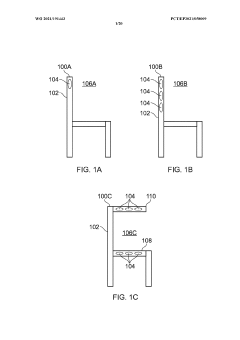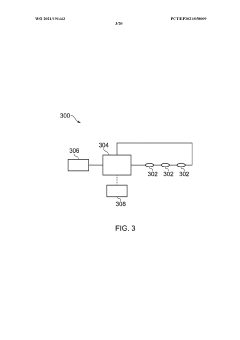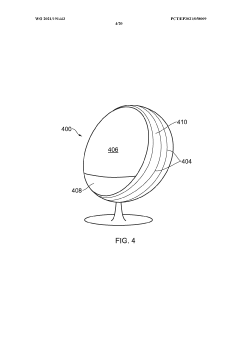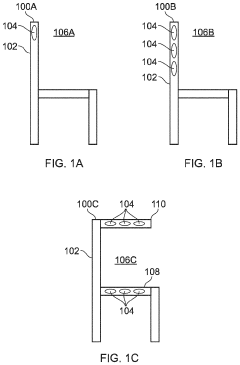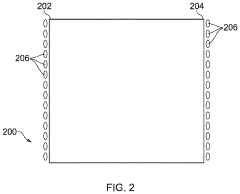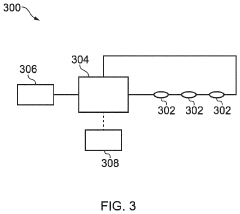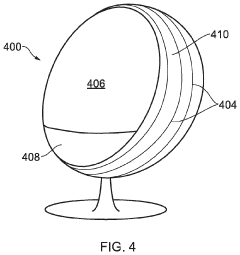Schumann Resonance and Planetary Wave Interactions
JUN 24, 20259 MIN READ
Generate Your Research Report Instantly with AI Agent
Patsnap Eureka helps you evaluate technical feasibility & market potential.
Schumann Resonance Background and Research Objectives
Schumann resonances, first predicted by Winfried Otto Schumann in 1952, are global electromagnetic resonances excited by lightning discharges in the cavity formed by the Earth's surface and the ionosphere. These resonances occur at extremely low frequencies (ELF) around 7.83 Hz and its harmonics. The study of Schumann resonances has gained significant attention in recent years due to their potential applications in various fields, including climate science, space weather monitoring, and even human health.
The primary objective of this research is to explore the interactions between Schumann resonances and planetary waves, which are large-scale atmospheric oscillations that play a crucial role in global weather patterns. Understanding these interactions could provide valuable insights into the complex relationships between the Earth's atmosphere, ionosphere, and magnetosphere.
One of the key goals is to investigate how planetary waves may modulate Schumann resonance parameters, such as frequency, amplitude, and phase. This research aims to identify potential correlations between variations in Schumann resonance characteristics and the behavior of planetary waves, which could lead to improved models for predicting atmospheric and ionospheric phenomena.
Another important aspect of this study is to examine the potential influence of Schumann resonances on planetary wave dynamics. By analyzing long-term data sets and employing advanced signal processing techniques, researchers hope to uncover any bidirectional coupling mechanisms between these two phenomena.
Furthermore, this research seeks to explore the implications of Schumann resonance and planetary wave interactions for global climate patterns. As both phenomena are sensitive to changes in atmospheric conditions, their interactions may provide valuable indicators of climate variability and long-term trends.
The study also aims to develop new methodologies for detecting and characterizing these interactions, potentially leading to improved techniques for monitoring and forecasting space weather events. This could have significant implications for satellite operations, communication systems, and other technologies vulnerable to ionospheric disturbances.
Ultimately, this research endeavors to contribute to our understanding of the Earth's complex electromagnetic environment and its relationship to atmospheric dynamics. By elucidating the connections between Schumann resonances and planetary waves, scientists hope to gain deeper insights into the intricate workings of our planet's atmospheric and electromagnetic systems, paving the way for advancements in various scientific disciplines and practical applications.
The primary objective of this research is to explore the interactions between Schumann resonances and planetary waves, which are large-scale atmospheric oscillations that play a crucial role in global weather patterns. Understanding these interactions could provide valuable insights into the complex relationships between the Earth's atmosphere, ionosphere, and magnetosphere.
One of the key goals is to investigate how planetary waves may modulate Schumann resonance parameters, such as frequency, amplitude, and phase. This research aims to identify potential correlations between variations in Schumann resonance characteristics and the behavior of planetary waves, which could lead to improved models for predicting atmospheric and ionospheric phenomena.
Another important aspect of this study is to examine the potential influence of Schumann resonances on planetary wave dynamics. By analyzing long-term data sets and employing advanced signal processing techniques, researchers hope to uncover any bidirectional coupling mechanisms between these two phenomena.
Furthermore, this research seeks to explore the implications of Schumann resonance and planetary wave interactions for global climate patterns. As both phenomena are sensitive to changes in atmospheric conditions, their interactions may provide valuable indicators of climate variability and long-term trends.
The study also aims to develop new methodologies for detecting and characterizing these interactions, potentially leading to improved techniques for monitoring and forecasting space weather events. This could have significant implications for satellite operations, communication systems, and other technologies vulnerable to ionospheric disturbances.
Ultimately, this research endeavors to contribute to our understanding of the Earth's complex electromagnetic environment and its relationship to atmospheric dynamics. By elucidating the connections between Schumann resonances and planetary waves, scientists hope to gain deeper insights into the intricate workings of our planet's atmospheric and electromagnetic systems, paving the way for advancements in various scientific disciplines and practical applications.
Global Demand for Atmospheric Research
The global demand for atmospheric research, particularly in the field of Schumann Resonance and planetary wave interactions, has been steadily increasing in recent years. This growing interest is driven by the critical role these phenomena play in understanding Earth's climate system, weather patterns, and potential impacts on human health and technology.
Atmospheric scientists and researchers worldwide are focusing on Schumann Resonance, a set of spectral peaks in the extremely low frequency (ELF) portion of the Earth's electromagnetic field spectrum. These resonances are excited by lightning discharges in the cavity formed by the Earth's surface and the ionosphere. The study of Schumann Resonance provides valuable insights into global lightning activity, ionospheric conditions, and potentially, climate change indicators.
Planetary waves, also known as Rossby waves, are another area of intense research interest. These large-scale meanders in atmospheric flow play a crucial role in weather patterns and climate variability. The interaction between Schumann Resonance and planetary waves is a complex and relatively unexplored area that holds promise for improving long-term weather forecasting and understanding climate dynamics.
The demand for research in this field is driven by several factors. Climate change concerns have heightened the need for better understanding of atmospheric processes and their interactions. Improved monitoring and prediction of extreme weather events, which can be influenced by planetary wave patterns, is a priority for many nations. Additionally, the potential impacts of Schumann Resonance on human health and technological systems have sparked interest from the medical and telecommunications sectors.
Research institutions, government agencies, and private companies are investing in advanced monitoring equipment and data analysis techniques to study these phenomena. Satellite-based observations, ground-based ELF monitoring stations, and sophisticated computer models are being developed and deployed to capture and analyze the complex interactions between Schumann Resonance and planetary waves.
International collaboration in this field is also on the rise. Joint research projects, data sharing initiatives, and global monitoring networks are being established to pool resources and expertise. This collaborative approach is essential given the global nature of atmospheric processes and the need for comprehensive, long-term datasets to understand these complex interactions.
The potential applications of this research are diverse and far-reaching. Improved weather forecasting and climate modeling are obvious benefits, but the insights gained could also inform strategies for mitigating climate change impacts, optimizing renewable energy systems, and even developing new therapeutic approaches in medicine based on the effects of natural electromagnetic fields on human physiology.
Atmospheric scientists and researchers worldwide are focusing on Schumann Resonance, a set of spectral peaks in the extremely low frequency (ELF) portion of the Earth's electromagnetic field spectrum. These resonances are excited by lightning discharges in the cavity formed by the Earth's surface and the ionosphere. The study of Schumann Resonance provides valuable insights into global lightning activity, ionospheric conditions, and potentially, climate change indicators.
Planetary waves, also known as Rossby waves, are another area of intense research interest. These large-scale meanders in atmospheric flow play a crucial role in weather patterns and climate variability. The interaction between Schumann Resonance and planetary waves is a complex and relatively unexplored area that holds promise for improving long-term weather forecasting and understanding climate dynamics.
The demand for research in this field is driven by several factors. Climate change concerns have heightened the need for better understanding of atmospheric processes and their interactions. Improved monitoring and prediction of extreme weather events, which can be influenced by planetary wave patterns, is a priority for many nations. Additionally, the potential impacts of Schumann Resonance on human health and technological systems have sparked interest from the medical and telecommunications sectors.
Research institutions, government agencies, and private companies are investing in advanced monitoring equipment and data analysis techniques to study these phenomena. Satellite-based observations, ground-based ELF monitoring stations, and sophisticated computer models are being developed and deployed to capture and analyze the complex interactions between Schumann Resonance and planetary waves.
International collaboration in this field is also on the rise. Joint research projects, data sharing initiatives, and global monitoring networks are being established to pool resources and expertise. This collaborative approach is essential given the global nature of atmospheric processes and the need for comprehensive, long-term datasets to understand these complex interactions.
The potential applications of this research are diverse and far-reaching. Improved weather forecasting and climate modeling are obvious benefits, but the insights gained could also inform strategies for mitigating climate change impacts, optimizing renewable energy systems, and even developing new therapeutic approaches in medicine based on the effects of natural electromagnetic fields on human physiology.
Current Challenges in SR-PW Interaction Studies
The study of Schumann Resonance (SR) and Planetary Wave (PW) interactions faces several significant challenges that hinder comprehensive understanding and accurate modeling of these complex phenomena. One of the primary obstacles is the multidisciplinary nature of the research, requiring expertise in atmospheric physics, geophysics, and electromagnetic theory. This complexity often leads to difficulties in integrating diverse datasets and methodologies.
Data acquisition presents another major hurdle. Continuous, high-quality measurements of both SR and PW are essential for meaningful analysis, yet obtaining such data is challenging due to the global scale of these phenomena. The need for a network of sensitive instruments distributed across various geographical locations adds to the logistical and financial constraints of data collection.
The inherent variability of the Earth's atmosphere further complicates SR-PW interaction studies. Atmospheric conditions fluctuate on multiple timescales, from diurnal to seasonal and even longer periods, making it difficult to isolate the specific effects of planetary waves on Schumann resonances. This variability also introduces noise into measurements, potentially masking subtle interaction signals.
Another significant challenge lies in the development of accurate numerical models that can simulate the complex interplay between SR and PW. These models must account for a wide range of factors, including ionospheric dynamics, global thunderstorm activity, and the Earth's magnetic field. The computational resources required for such comprehensive simulations are substantial, often limiting the resolution and scope of model-based studies.
The interpretation of observed correlations between SR and PW also poses difficulties. Distinguishing between causal relationships and mere coincidences requires sophisticated statistical analyses and a deep understanding of the underlying physical mechanisms. This challenge is exacerbated by the potential for multiple feedback loops and indirect effects within the Earth-atmosphere system.
Furthermore, the relatively low amplitude of SR signals compared to other electromagnetic phenomena in the same frequency range makes detection and analysis challenging. Anthropogenic electromagnetic noise, particularly in populated areas, can significantly interfere with SR measurements, necessitating careful site selection and advanced signal processing techniques.
Lastly, the interdisciplinary nature of SR-PW interaction research often leads to communication barriers between different scientific communities. Bridging the gap between atmospheric scientists, geophysicists, and electromagnetic specialists is crucial for advancing the field but remains a persistent challenge in fostering collaborative research efforts and sharing knowledge across disciplines.
Data acquisition presents another major hurdle. Continuous, high-quality measurements of both SR and PW are essential for meaningful analysis, yet obtaining such data is challenging due to the global scale of these phenomena. The need for a network of sensitive instruments distributed across various geographical locations adds to the logistical and financial constraints of data collection.
The inherent variability of the Earth's atmosphere further complicates SR-PW interaction studies. Atmospheric conditions fluctuate on multiple timescales, from diurnal to seasonal and even longer periods, making it difficult to isolate the specific effects of planetary waves on Schumann resonances. This variability also introduces noise into measurements, potentially masking subtle interaction signals.
Another significant challenge lies in the development of accurate numerical models that can simulate the complex interplay between SR and PW. These models must account for a wide range of factors, including ionospheric dynamics, global thunderstorm activity, and the Earth's magnetic field. The computational resources required for such comprehensive simulations are substantial, often limiting the resolution and scope of model-based studies.
The interpretation of observed correlations between SR and PW also poses difficulties. Distinguishing between causal relationships and mere coincidences requires sophisticated statistical analyses and a deep understanding of the underlying physical mechanisms. This challenge is exacerbated by the potential for multiple feedback loops and indirect effects within the Earth-atmosphere system.
Furthermore, the relatively low amplitude of SR signals compared to other electromagnetic phenomena in the same frequency range makes detection and analysis challenging. Anthropogenic electromagnetic noise, particularly in populated areas, can significantly interfere with SR measurements, necessitating careful site selection and advanced signal processing techniques.
Lastly, the interdisciplinary nature of SR-PW interaction research often leads to communication barriers between different scientific communities. Bridging the gap between atmospheric scientists, geophysicists, and electromagnetic specialists is crucial for advancing the field but remains a persistent challenge in fostering collaborative research efforts and sharing knowledge across disciplines.
Existing Methodologies for SR-PW Analysis
01 Schumann resonance detection and measurement devices
Various devices and systems have been developed to detect and measure Schumann resonances. These devices typically include sensors, antennas, and signal processing components to capture and analyze the low-frequency electromagnetic waves associated with Schumann resonances. Some designs incorporate multiple sensors for improved accuracy and noise reduction.- Schumann resonance detection and measurement devices: Various devices and systems have been developed to detect and measure Schumann resonances. These devices typically include sensors, antennas, and signal processing units to capture and analyze the low-frequency electromagnetic waves associated with Schumann resonances. Some designs incorporate multiple sensors for improved accuracy and noise reduction.
- Applications of Schumann resonance in health and wellness: Schumann resonance has been explored for potential health benefits and wellness applications. Some inventions focus on creating artificial Schumann resonance environments or devices that emit frequencies matching natural Schumann resonances. These applications aim to improve sleep quality, reduce stress, and enhance overall well-being.
- Integration of Schumann resonance in electronic devices: Various electronic devices have been designed to incorporate Schumann resonance technology. These include wearable devices, mobile phones, and other personal electronics. The integration aims to provide users with potential benefits associated with Schumann resonances in their daily lives, such as improved focus or relaxation.
- Planetary wave monitoring and analysis systems: Systems and methods have been developed for monitoring and analyzing planetary waves. These inventions typically involve satellite-based or ground-based sensors, data processing algorithms, and visualization tools to track and study large-scale atmospheric oscillations. Applications include weather forecasting, climate research, and environmental monitoring.
- Combined Schumann resonance and planetary wave research: Some inventions focus on the combined study of Schumann resonances and planetary waves. These systems aim to investigate potential correlations between the two phenomena and their effects on Earth's atmosphere and climate. Such research may involve complex measurement setups, data analysis techniques, and modeling approaches to understand the interactions between these global-scale processes.
02 Applications of Schumann resonance in health and wellness
Schumann resonance has been explored for potential health and wellness applications. Some inventions propose using Schumann resonance frequencies in therapeutic devices, meditation aids, or sleep improvement tools. These applications often involve generating or simulating Schumann resonance frequencies to create environments believed to have positive effects on human physiology and mental state.Expand Specific Solutions03 Integration of Schumann resonance in electronic devices
Several patents describe the integration of Schumann resonance concepts into various electronic devices and systems. These may include incorporating Schumann resonance frequencies into communication systems, environmental monitoring equipment, or consumer electronics to potentially enhance their performance or add new functionalities.Expand Specific Solutions04 Planetary wave monitoring and analysis systems
Inventions related to monitoring and analyzing planetary waves, which are large-scale atmospheric oscillations, have been developed. These systems may involve satellite-based observations, ground-based sensors, or computational models to track and predict planetary wave behavior, which can have significant impacts on global weather patterns and climate.Expand Specific Solutions05 Combined Schumann resonance and planetary wave research tools
Some inventions focus on developing research tools and methodologies that combine the study of Schumann resonances and planetary waves. These may include advanced data analysis techniques, specialized sensors, or integrated monitoring systems that allow scientists to investigate potential relationships between these phenomena and their effects on Earth's atmosphere and climate.Expand Specific Solutions
Key Institutions in Atmospheric Science
The research on Schumann Resonance and Planetary Wave Interactions is in an early developmental stage, with a growing market potential in atmospheric and geophysical studies. The technology's maturity is still evolving, as evidenced by the diverse range of institutions involved. Universities like Beihang University, Nanjing University of Aeronautics & Astronautics, and National Taiwan University are at the forefront, indicating a strong academic focus. Research organizations such as the Centre National de la Recherche Scientifique and HRL Laboratories LLC are also contributing significantly. The involvement of corporations like Intel Corp. and Hitachi Ltd. suggests potential commercial applications, although these are likely still in the exploratory phase. The global nature of the research, with participants from multiple countries, underscores the technology's broad interest and potential impact on understanding Earth-atmosphere interactions.
Hitachi Ltd.
Technical Solution: Hitachi has developed advanced sensor technologies and data analysis methods for studying Schumann Resonance and planetary wave interactions. Their approach combines high-sensitivity magnetometers with sophisticated signal processing algorithms to detect and analyze extremely low frequency (ELF) electromagnetic waves. Hitachi's system can differentiate between Schumann Resonances and other planetary wave phenomena, allowing for more accurate measurements of global electromagnetic activity and its potential impacts on climate and weather patterns.
Strengths: Advanced sensor technology, sophisticated data analysis capabilities. Weaknesses: Limited field deployment experience, potential high costs for large-scale implementation.
Centre National de la Recherche Scientifique
Technical Solution: CNRS has developed a comprehensive research program on Schumann Resonance and planetary wave interactions. Their approach involves a network of ground-based ELF monitoring stations across different geographical locations, combined with satellite-based observations. CNRS researchers use advanced spectral analysis techniques and machine learning algorithms to identify correlations between Schumann Resonances, planetary waves, and various atmospheric and ionospheric phenomena. Their work aims to improve our understanding of global electromagnetic circuits and their role in Earth's climate system.
Strengths: Extensive research network, multidisciplinary approach. Weaknesses: Complexity in data integration from various sources, potential gaps in global coverage.
Breakthrough Studies in SR-PW Interactions
A magnetic field exposure system and uses thereof
PatentWO2021191443A1
Innovation
- A magnetic field exposure system generating an amplitude-modulated low frequency magnetic field with a carrier frequency of 360 to 450 Hz and a modulation frequency of 0.5 to 100 Hz, with a field strength of 0.5 to 250 mT, specifically designed to expose organic cells or tissues to improve cell survival, proliferation, reduce stress, and enhance well-being.
A magnetic field exposure system and uses thereof
PatentPendingUS20230372726A1
Innovation
- A magnetic field exposure system generating an amplitude-modulated low frequency magnetic field with a carrier frequency of 360 to 450 Hz and a modulation frequency of 0.5 to 100 Hz, providing a field strength of 0.5 to 250 μT, specifically designed to enhance cell survival, proliferation, reduce stress, and promote tissue regeneration.
Climate Change Impact on SR-PW Dynamics
Climate change has emerged as a significant factor influencing the dynamics between Schumann Resonance (SR) and Planetary Waves (PW). As global temperatures rise and weather patterns shift, the interactions between these two atmospheric phenomena are undergoing notable alterations. The increasing frequency and intensity of extreme weather events, such as hurricanes, droughts, and heatwaves, are directly impacting the Earth's electromagnetic environment, which in turn affects SR-PW interactions.
One of the primary ways climate change impacts SR-PW dynamics is through alterations in atmospheric conductivity. Rising temperatures lead to increased water vapor content in the atmosphere, which can modify the electrical properties of the air. This change in conductivity affects the propagation of electromagnetic waves, potentially altering the characteristics of Schumann Resonances. Additionally, changes in global circulation patterns due to climate change can influence the behavior of planetary waves, leading to shifts in their amplitude, frequency, and spatial distribution.
The melting of polar ice caps and the subsequent rise in sea levels also play a crucial role in modifying SR-PW interactions. As the Earth's surface composition changes, it affects the reflection and absorption of electromagnetic waves, potentially altering the global resonance patterns. Furthermore, changes in ocean temperatures and currents can influence the generation and propagation of planetary waves, leading to complex feedback mechanisms between SR and PW.
Climate change-induced variations in the ionosphere's composition and structure are another critical factor affecting SR-PW dynamics. The ionosphere plays a vital role in the propagation of electromagnetic waves, and any alterations to its properties can significantly impact Schumann Resonances. Changes in solar activity, which are indirectly influenced by climate change through complex atmospheric interactions, can also modify the ionospheric conditions, further complicating the SR-PW relationship.
The impact of climate change on SR-PW dynamics extends beyond atmospheric effects. Changes in vegetation cover, particularly deforestation and desertification, can alter the Earth's surface conductivity and reflectivity, influencing both SR and PW characteristics. Moreover, the increasing prevalence of anthropogenic electromagnetic noise due to technological advancements and urbanization, which are indirectly linked to climate change, adds another layer of complexity to the SR-PW interaction studies.
Understanding these climate change-induced alterations in SR-PW dynamics is crucial for various scientific and practical applications. It has implications for global communication systems, weather forecasting models, and even potential early warning systems for natural disasters. As research in this field progresses, it becomes increasingly important to develop sophisticated models that can accurately predict and account for these complex interactions in a changing climate.
One of the primary ways climate change impacts SR-PW dynamics is through alterations in atmospheric conductivity. Rising temperatures lead to increased water vapor content in the atmosphere, which can modify the electrical properties of the air. This change in conductivity affects the propagation of electromagnetic waves, potentially altering the characteristics of Schumann Resonances. Additionally, changes in global circulation patterns due to climate change can influence the behavior of planetary waves, leading to shifts in their amplitude, frequency, and spatial distribution.
The melting of polar ice caps and the subsequent rise in sea levels also play a crucial role in modifying SR-PW interactions. As the Earth's surface composition changes, it affects the reflection and absorption of electromagnetic waves, potentially altering the global resonance patterns. Furthermore, changes in ocean temperatures and currents can influence the generation and propagation of planetary waves, leading to complex feedback mechanisms between SR and PW.
Climate change-induced variations in the ionosphere's composition and structure are another critical factor affecting SR-PW dynamics. The ionosphere plays a vital role in the propagation of electromagnetic waves, and any alterations to its properties can significantly impact Schumann Resonances. Changes in solar activity, which are indirectly influenced by climate change through complex atmospheric interactions, can also modify the ionospheric conditions, further complicating the SR-PW relationship.
The impact of climate change on SR-PW dynamics extends beyond atmospheric effects. Changes in vegetation cover, particularly deforestation and desertification, can alter the Earth's surface conductivity and reflectivity, influencing both SR and PW characteristics. Moreover, the increasing prevalence of anthropogenic electromagnetic noise due to technological advancements and urbanization, which are indirectly linked to climate change, adds another layer of complexity to the SR-PW interaction studies.
Understanding these climate change-induced alterations in SR-PW dynamics is crucial for various scientific and practical applications. It has implications for global communication systems, weather forecasting models, and even potential early warning systems for natural disasters. As research in this field progresses, it becomes increasingly important to develop sophisticated models that can accurately predict and account for these complex interactions in a changing climate.
Space Weather Implications of SR-PW Interactions
The interactions between Schumann Resonances (SR) and Planetary Waves (PW) have significant implications for space weather phenomena. These interactions can influence various aspects of the Earth's atmosphere and ionosphere, potentially affecting satellite communications, navigation systems, and other space-based technologies.
One of the primary space weather implications of SR-PW interactions is their impact on the ionospheric dynamics. The coupling between these two phenomena can lead to perturbations in the ionospheric electron density and temperature, which in turn can affect radio wave propagation. This is particularly important for high-frequency (HF) communications and Global Navigation Satellite Systems (GNSS), as changes in the ionospheric conditions can cause signal scintillation and degradation of positioning accuracy.
Furthermore, SR-PW interactions may play a role in modulating the occurrence and intensity of ionospheric irregularities, such as equatorial plasma bubbles and mid-latitude irregularities. These irregularities can disrupt radio signals and cause communication outages, posing challenges for both terrestrial and space-based communication systems.
The coupling between SR and PW can also influence the distribution of atmospheric electric fields and currents. This has potential implications for the global electric circuit and may contribute to the generation of geomagnetically induced currents (GICs) in power grids during geomagnetic storms. Understanding these interactions is crucial for improving space weather forecasting models and developing mitigation strategies for vulnerable infrastructure.
Another important aspect of SR-PW interactions in the context of space weather is their potential influence on the vertical coupling between different atmospheric layers. This coupling can affect the transfer of energy and momentum from the lower atmosphere to the upper atmosphere and ionosphere, potentially modifying the thermospheric density and composition. Such changes can impact satellite drag and orbital dynamics, which are critical factors in satellite operations and space debris management.
The study of SR-PW interactions may also provide insights into long-term climate variability and its relationship to space weather. By examining the correlations between these phenomena and solar activity cycles, researchers can gain a better understanding of the complex interplay between solar-terrestrial processes and their effects on Earth's climate system.
One of the primary space weather implications of SR-PW interactions is their impact on the ionospheric dynamics. The coupling between these two phenomena can lead to perturbations in the ionospheric electron density and temperature, which in turn can affect radio wave propagation. This is particularly important for high-frequency (HF) communications and Global Navigation Satellite Systems (GNSS), as changes in the ionospheric conditions can cause signal scintillation and degradation of positioning accuracy.
Furthermore, SR-PW interactions may play a role in modulating the occurrence and intensity of ionospheric irregularities, such as equatorial plasma bubbles and mid-latitude irregularities. These irregularities can disrupt radio signals and cause communication outages, posing challenges for both terrestrial and space-based communication systems.
The coupling between SR and PW can also influence the distribution of atmospheric electric fields and currents. This has potential implications for the global electric circuit and may contribute to the generation of geomagnetically induced currents (GICs) in power grids during geomagnetic storms. Understanding these interactions is crucial for improving space weather forecasting models and developing mitigation strategies for vulnerable infrastructure.
Another important aspect of SR-PW interactions in the context of space weather is their potential influence on the vertical coupling between different atmospheric layers. This coupling can affect the transfer of energy and momentum from the lower atmosphere to the upper atmosphere and ionosphere, potentially modifying the thermospheric density and composition. Such changes can impact satellite drag and orbital dynamics, which are critical factors in satellite operations and space debris management.
The study of SR-PW interactions may also provide insights into long-term climate variability and its relationship to space weather. By examining the correlations between these phenomena and solar activity cycles, researchers can gain a better understanding of the complex interplay between solar-terrestrial processes and their effects on Earth's climate system.
Unlock deeper insights with Patsnap Eureka Quick Research — get a full tech report to explore trends and direct your research. Try now!
Generate Your Research Report Instantly with AI Agent
Supercharge your innovation with Patsnap Eureka AI Agent Platform!
